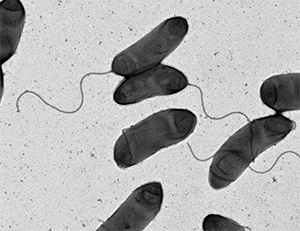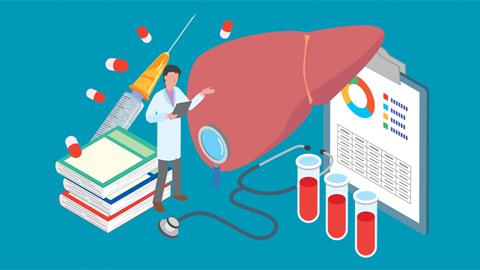JBC: Antibiotic resistance in pandemic cholera
Cholera is a devastating disease for millions worldwide, primarily in developing countries, and the dominant type of cholera today is naturally resistant to one type of antibiotic usually used as a treatment of last resort.
 This image shows an electron micrograph of the bacterium Vibrio cholerae, the causative agent of cholera. courtesy of M. Stephen Trent/University of Georgia
This image shows an electron micrograph of the bacterium Vibrio cholerae, the causative agent of cholera. courtesy of M. Stephen Trent/University of Georgia
Researchers at the University of Georgia now have shown that the enzyme that makes the El Tor family of Vibrio cholera resistant to those antibiotics has a different mechanism of action from any comparable proteins observed in bacteria so far. Understanding that mechanism better equips researchers to overcome the challenge it presents in a world with increasing antibiotic resistance. The research was published in the Journal of Biological Chemistry.
Cationic antimicrobial peptides, or CAMPs, are produced naturally by bacteria and by animals’ innate immune systems and also are synthesized for use as last-line drugs. Cholera strains achieve resistance to CAMPs by chemically disguising the bacterium’s cell wall, which prevents CAMPs from binding, disrupting the wall and killing the bacterium. M. Stephen Trent’s research team in Georgia previously had shown that a group of three proteins carried out this modification and had elucidated the functions of two of the proteins. The team reported the role of the third protein — the missing piece in understanding CAMP resistance — in the new paper.
Jeremy Henderson, then a graduate student, led a research project that showed that this enzyme, AlmG, attaches glycine, the smallest of the amino acids, to lipid A, one of the components of the outer membrane of the bacterial cell. This modification changes the charge of the lipid A molecules, preventing CAMPs from binding.
Lipid A modification is a defense mechanism observed in other bacteria, but detailed biochemical characterization of AlmG showed that the way this process occurred in cholera was unique.
“It became apparent over the course of our work that how (this enzyme) improves shield functionality is quite different than would be expected based on what we know about groups of enzymes that look similar,” Henderson said.
AlmG is structured differently from other lipid A-modifying enzymes, with a different active site responsible for carrying out the modification. In addition, AlmG can add either one or two glycines to the same lipid A molecule, which also has not been observed in other bacteria. “It just opens up the door for this operating with a completely different mechanism than what’s been described in the literature for related proteins,” Henderson said.
Genes encoding determinants of antibiotic resistance can spread between different species of bacteria, so the unique mechanism of CAMP drug resistance in V. cholerae is of potential concern if it jumps to bacteria already resistant to first-line drugs. “The level of protection conferred by this particular modification in Vibrio cholerae puts it in a league of its own,” Henderson said.
Enjoy reading ASBMB Today?
Become a member to receive the print edition monthly and the digital edition weekly.
Learn moreGet the latest from ASBMB Today
Enter your email address, and we’ll send you a weekly email with recent articles, interviews and more.
Latest in Science
Science highlights or most popular articles

Iron could be key to treating a global parasitic disease
A study has found that leishmaniasis causes body-wide changes in iron balance, leading to red blood cell damage.

Environmental DNA is everywhere
The ability to extract trace bits of DNA from soil, water, and even air is revolutionizing science. Are there pitfalls?

Early COVID-19 research is riddled with poor methods and low-quality results
The pandemic worsened, but didn’t create, this problem for science.

From the journals: MCP
Three views of mass spec: analyzing secreted protein spectra, imaging mass spectrometry for clinical use and spectral libraries for MS data analysis. Read about these recent papers.

Understanding the fat science
Researchers at UCLA investigate lipid remodeling in the liver for energy generation.

No oxygen? No problem
By studying how electric fish survive in hypoxic streams for months at time, researchers may find new ways to target tumors.

.jpg?lang=en-US&width=300&height=300&ext=.jpg)